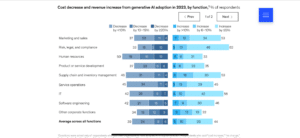Artificial intelligence (AI) has reached a tipping point. According to a recent McKinsey Global Survey, AI adoption reached 72% overall in 2023, a jump from 50% the year before. AI is no longer on the horizon, it’s here. On the spectrum from enthusiasts to pessimists, not taking AI seriously or denying its impact is not an option anymore. For those who have buried their heads in the sand, it is time to take a look at the reality, Like it or not.
The following data from McKinsey’s survey shows that AI adoption in HR has scored the greatest cost decrease among all areas, and a substantial revenue increase as well:

HR professionals, leaders, and managers need to get ready for what’s in store. This article will consider some of the rewards and risks in adopting AI for human capital and talent management.
Here are some of the ways AI can be used in HR and talent management.
Recruitment. Use AI to automate repetitive tasks and create a better experience for candidates. Without AI, creating job postings, reviewing qualifications, scheduling interviews, and the like can be inefficient and time consuming. The result is extra cost and the loss of promising candidates.
AI is well suited to reviewing stacks of resumes to match candidates with open positions. Some organizations also use AI to search for candidates on websites like LinkedIn and GitHub. The most promising candidates and prospects can be flagged for HR staff, freeing their time for more demanding, human-to-human tasks.
Learning and Development. Organizations can use AI to create individualized plans to maximize each employee’s potential. Without AI, information about training opportunities can be hard to find, and individuals may seek out skills that are “hot” and in demand, instead of building toward long term career goals. AI tools can remedy that by analyzing individual skills, identifying needs, and creating a comprehensive long term plan.
AI can also promote career development by matching individuals to opportunities within the organization. Too often managers recruit from outside when they have an open position. By providing the ability to search for talent “in-house,” AI can save time and resources while helping individuals advance their careers within the organization.
Engagement and Productivity. AI in HR is beginning to turn the annual performance review into a continuous feedback system. AI applications can help employees track progress and set goals. They can also help employees and managers find areas where training or new skills can improve performance.
AI can also monitor employee sentiment and engagement in real time through surveys, feedback, and data analysis. More controversially, AI can monitor email, messaging, and other data for signs of burnout, disengagement, or misconduct. Some AI applications can offer resources for improved employee well-being.
Privacy and tracking. Workplace tracking is a hot button issue. According to the Harvard Business Review, up to 50% of large employers have adopted AI tools to monitor employee performance – sometimes on a “click-by-click” basis, in a Big Brother fashion. The result can be distrust, disengagement, quiet quitting, burnout, and higher turnover.
To address the problem, organizations need to recognize individual needs for respect and autonomy. Let employees know exactly what is being tracked and why. Consider tracking for information, and not for evaluation purposes. Performance monitoring is a tricky issue that needs careful consideration.
Errors and Bias. As reported in Business News Daily, 88% of HR executives in a Harvard Business School survey found that their AI tools reject qualified candidates. One problem was listing too many qualifications. The AI couldn’t weigh the importance of different skills, screening out good candidates.
Another problem is bias, both in the AI tool and the data it relies on. Amazon’s recruitment AI is known to have put female applicants at a disadvantage, for example. To address bias, organizations need to be proactive in setting fairness criteria and standards for transparency, so bias can be identified and corrected.
Legal issues. A final area of concern is legal risk. AI regulation is a developing field, there are not adequate regulations at federal and state levels. State regulations can lead to different standards from state to state. Organizations may be liable for discrimination and other violations of employment laws caused by AI. Organizations need to stay vigilant in this changing landscape.
Automated layoffs are another controversial issue. Business News Daily reports that many large companies, including Amazon, use algorithms to fire people. So-called “rank stacking” uses statistics to weed out low performers, with or without human oversight. States including New York have passed laws aimed at mitigating the effects of the practice.
© Dr. Vic all rights reserved.
TEP.Global not only has a combined 100 years of experience and expertise in people management, talent acquisition, executive assessment, but also deep knowledge in building teams and workplace culture in organizations of all sizes. For more information and insights, please contact us.
Leave a Reply